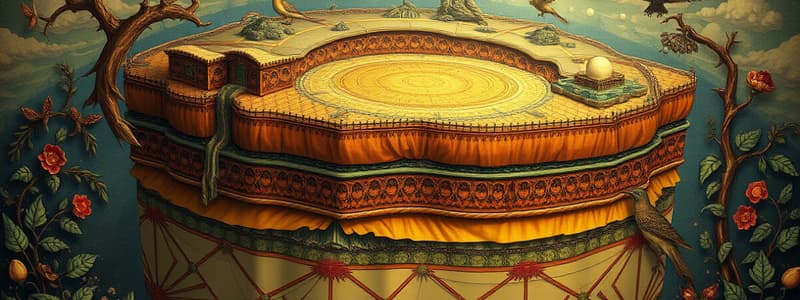Podcast
Questions and Answers
The geographer's concern with Earth's interior is restricted primarily to its influence on ________.
The geographer's concern with Earth's interior is restricted primarily to its influence on ________.
Earth surface features
The ________ is the thinnest layer.
The ________ is the thinnest layer.
crust
The lithosphere is sometimes defined as the ________.
The lithosphere is sometimes defined as the ________.
crust and upper mantle
The proof for the long-doubted idea of drifting continents came in the form of ________.
The proof for the long-doubted idea of drifting continents came in the form of ________.
Oceanic crust is denser than continental crust.
Oceanic crust is denser than continental crust.
Which of the following is NOT a property of minerals?
Which of the following is NOT a property of minerals?
The most widespread oxides are those that combine oxygen and ________.
The most widespread oxides are those that combine oxygen and ________.
________ is an example of a native element.
________ is an example of a native element.
The basic classification of rock types is based on their ________.
The basic classification of rock types is based on their ________.
Igneous rocks deposited on the surface and then cooled are known as ________.
Igneous rocks deposited on the surface and then cooled are known as ________.
Sedimentary deposits built into relatively regular layers are known as ________.
Sedimentary deposits built into relatively regular layers are known as ________.
Shale, sandstone, breccia, and limestone are all rocks that are classified as ________.
Shale, sandstone, breccia, and limestone are all rocks that are classified as ________.
The most commonly occurring type of metamorphic rocks are gneiss and ________.
The most commonly occurring type of metamorphic rocks are gneiss and ________.
Marble is metamorphosed ________.
Marble is metamorphosed ________.
Why is the rock cycle important?
Why is the rock cycle important?
The concept of plate tectonics is related to ________.
The concept of plate tectonics is related to ________.
The asthenosphere is the portion of Earth's interior between the lithosphere and lower mantle.
The asthenosphere is the portion of Earth's interior between the lithosphere and lower mantle.
The Moho is the boundary between the crust and the ________.
The Moho is the boundary between the crust and the ________.
Limestone is composed primarily of ________.
Limestone is composed primarily of ________.
Which of the following describes the vast majority of rock exposed on Earth's land surface?
Which of the following describes the vast majority of rock exposed on Earth's land surface?
Where is the Mohorovicic discontinuity found?
Where is the Mohorovicic discontinuity found?
The circulation within Earth's outer core is responsible for _____________.
The circulation within Earth's outer core is responsible for _____________.
Which rock type is associated correctly with an example?
Which rock type is associated correctly with an example?
What mineral is composed of oxygen and sulfur in combination with some other element?
What mineral is composed of oxygen and sulfur in combination with some other element?
Which extrusive igneous rock is—but for its faster cooling rate—equivalent to granite?
Which extrusive igneous rock is—but for its faster cooling rate—equivalent to granite?
Which of the following igneous rocks is plutonic?
Which of the following igneous rocks is plutonic?
Which of the following rocks is volcanic?
Which of the following rocks is volcanic?
What holds most sedimentary rocks together?
What holds most sedimentary rocks together?
A sedimentary rock that is made up of bits and pieces of other rock is known as a ___________ sedimentary rock, whereas a sedimentary rock that is precipitated from solution is known as ___________ sedimentary rock.
A sedimentary rock that is made up of bits and pieces of other rock is known as a ___________ sedimentary rock, whereas a sedimentary rock that is precipitated from solution is known as ___________ sedimentary rock.
What are metamorphic rocks called when they display a prominent alignment of their minerals?
What are metamorphic rocks called when they display a prominent alignment of their minerals?
How is relief best described?
How is relief best described?
Which of the following are internal processes?
Which of the following are internal processes?
What does uniformitarianism mean?
What does uniformitarianism mean?
Which is the proper order of the eras on the geologic time scale, from oldest to most recent?
Which is the proper order of the eras on the geologic time scale, from oldest to most recent?
Which topographic feature exhibits the largest scale view of Earth?
Which topographic feature exhibits the largest scale view of Earth?
Flashcards are hidden until you start studying
Study Notes
Earth's Interior and Surface Features
- Geographers focus on how Earth's interior influences surface features.
- The Earth's crust is the thinnest layer, foundational to understanding geological structure.
- The lithosphere comprises the crust and upper mantle, a critical boundary in geology.
Continental Drift and Geological Evidence
- The concept of drifting continents gained acceptance through analysis of magnetic and seismic patterns.
- Oceanic crust is denser than continental crust, a fundamental difference shaping geological dynamics.
Mineral Properties
- Minerals can be human-made, challenging traditional definitions of natural formations.
- Widespread oxides combine primarily with iron, essential for various geological processes.
Rock Types and Classifications
- Rocks are classified based on their origin: igneous, sedimentary, and metamorphic.
- Igneous rocks that cool on the surface are termed extrusive, such as rhyolite.
- Sedimentary deposits that form regular layers are known as strata, exemplifying natural layering processes.
- Common sedimentary rocks include shale, sandstone, breccia, and limestone, all classified as clastic.
Metamorphic Rocks
- The most common metamorphic rocks are gneiss and schist.
- Marble, another significant metamorphic rock, is formed from limestone through metamorphism.
Rock Cycle Significance
- The rock cycle illustrates how materials cycle through different rock classes over time, highlighting geological transformations.
- The concept of plate tectonics connects to faulting and volcanic activities, explaining earth movements and geological features.
Geophysical Layers
- The asthenosphere lies between the lithosphere and the lower mantle, indicating a differentiated structure within Earth.
- The Mohorovicic discontinuity, or Moho, marks the boundary between the crust and the mantle, crucial for understanding geological layers.
Composition of Rocks
- Limestone is primarily composed of calcite, a key mineral in sedimentary formations.
- The vast majority of rocks exposed on Earth's land surface are sedimentary, reflecting historical geological processes.
Magnetic Field Generation
- Circulation within Earth’s outer core is integral for generating the magnetic field, crucial for life and navigation.
Rock Examples
- Bituminous coal is an example of sedimentary rock, illustrating mineral classifications.
- Rocks classified as volcanic, such as andesite, are distinguished from plutonic rocks like gabbro.
Cementation and Rock Formation
- Cementing agents that precipitate from water hold most sedimentary rocks together, essential for rock cohesion.
- Clastic sedimentary rocks originate from fragmented rocks, while chemical sedimentary rocks form through precipitation.
Mineral Alignment in Metamorphic Rocks
- Foliated metamorphic rocks display prominent alignment of minerals, a result of pressure and heat during formation.
Relief and Geological Processes
- Relief is quantified by the elevation differences in landforms, key to understanding terrain variation.
- Internal geological processes include vulcanism, essential for shaping Earth's surface.
Uniformitarianism Principle
- Uniformitarianism posits that present physical processes were consistent in the past, driving gradual and cumulative changes in landscape.
Geological Time Scale
- The geologic time scale is ordered as Precambrian, Paleozoic, Mesozoic, and Cenozoic, marking Earth's historical eras.
Topographic Features
- River meanders represent large-scale topographic features, exemplifying the impact of erosion and sediment deposition.
Studying That Suits You
Use AI to generate personalized quizzes and flashcards to suit your learning preferences.




